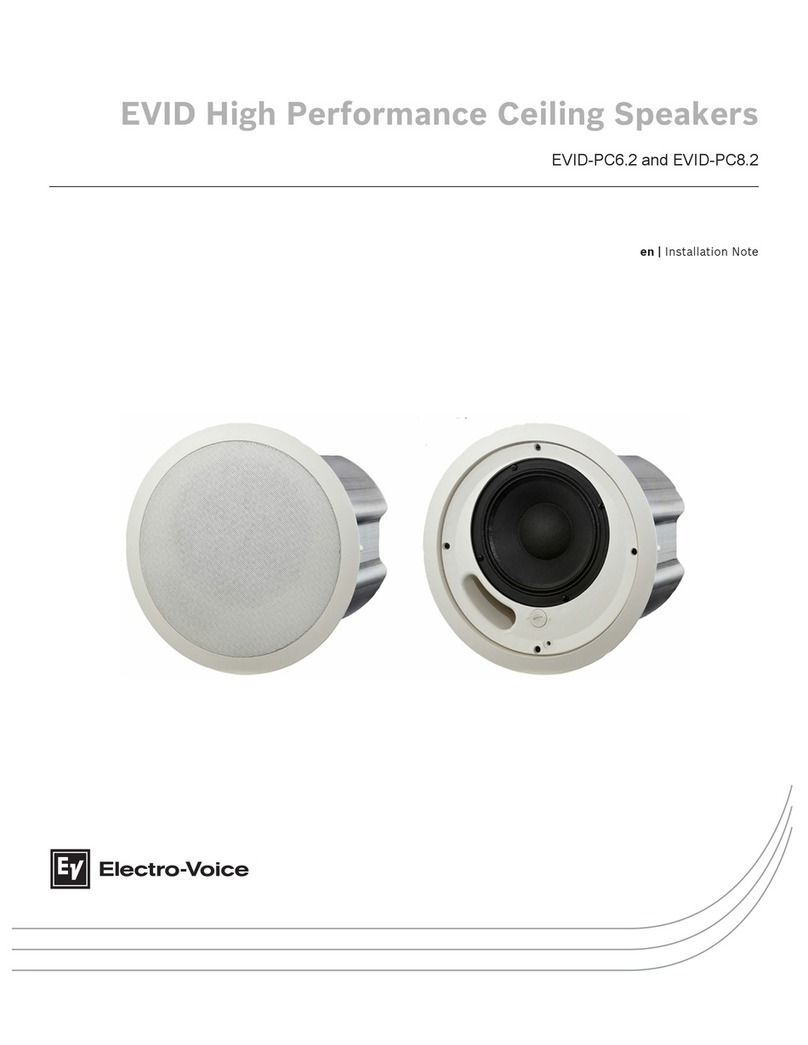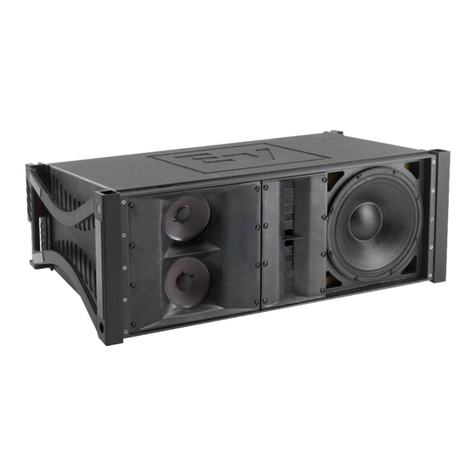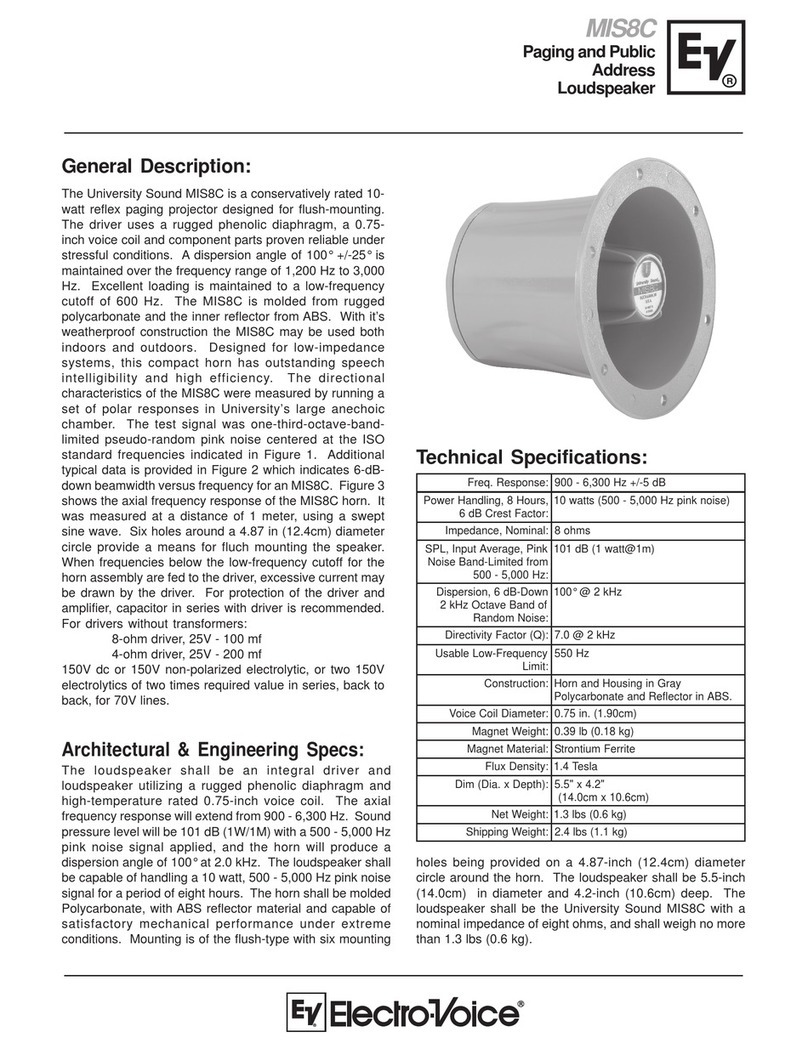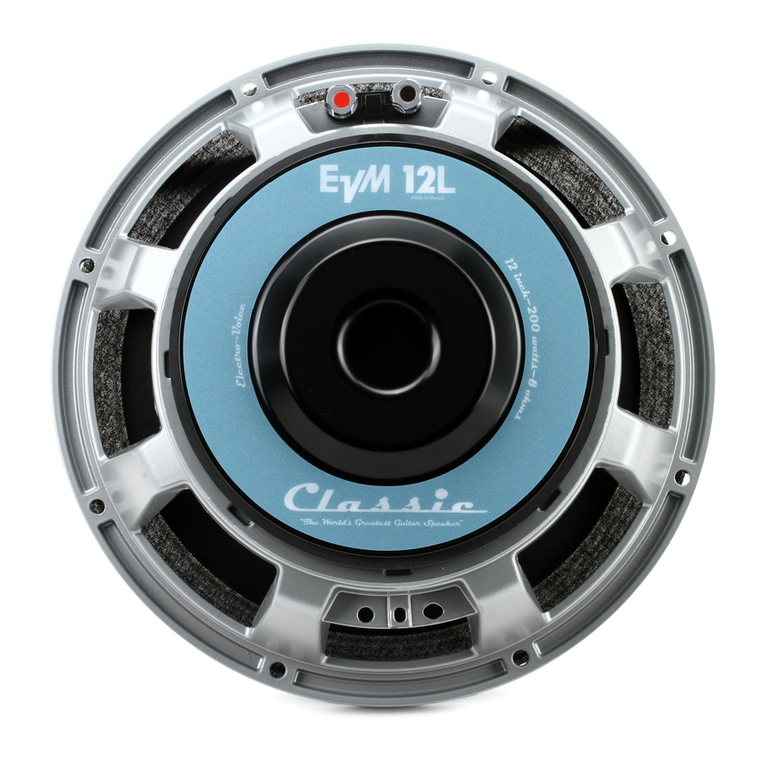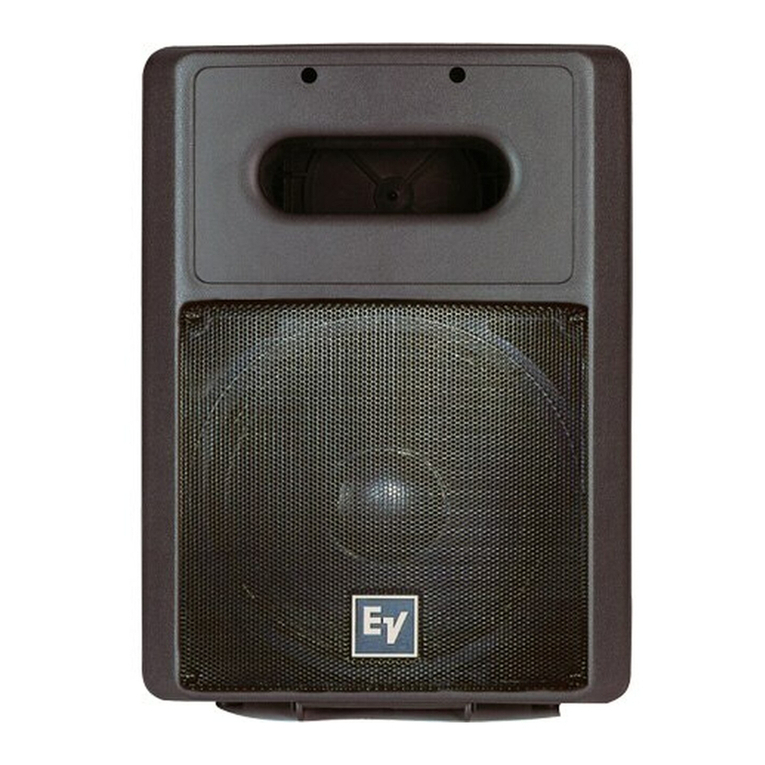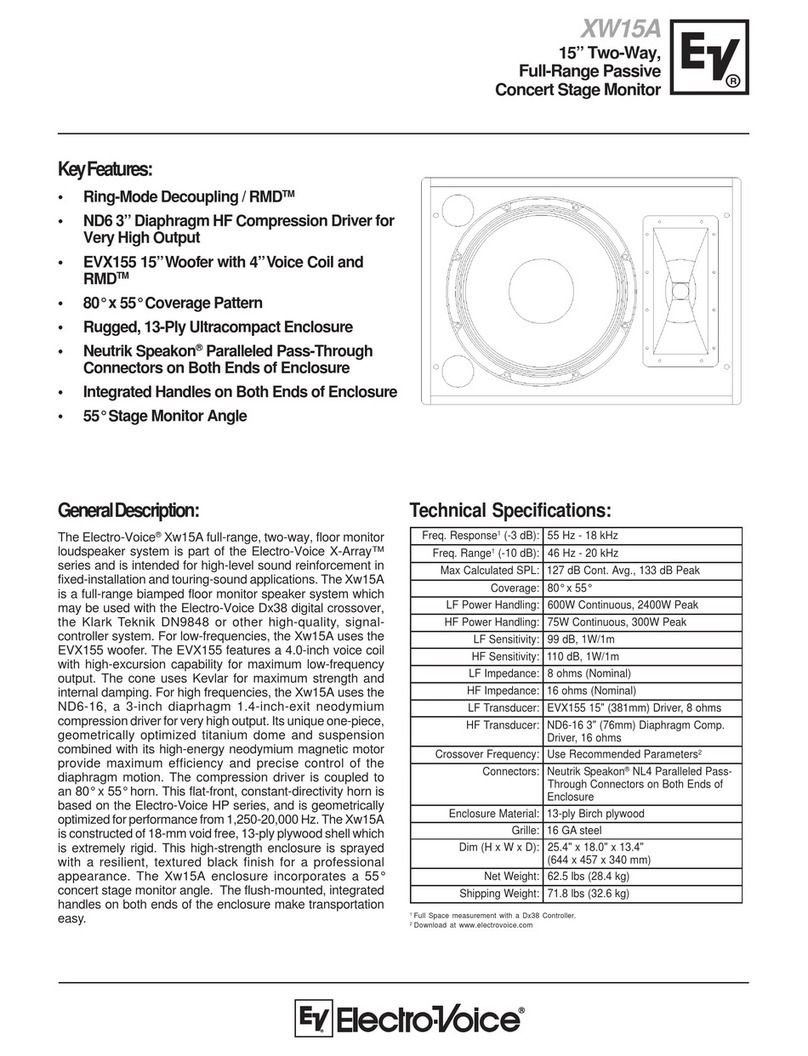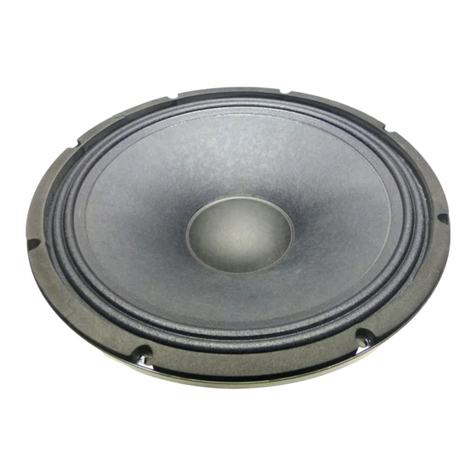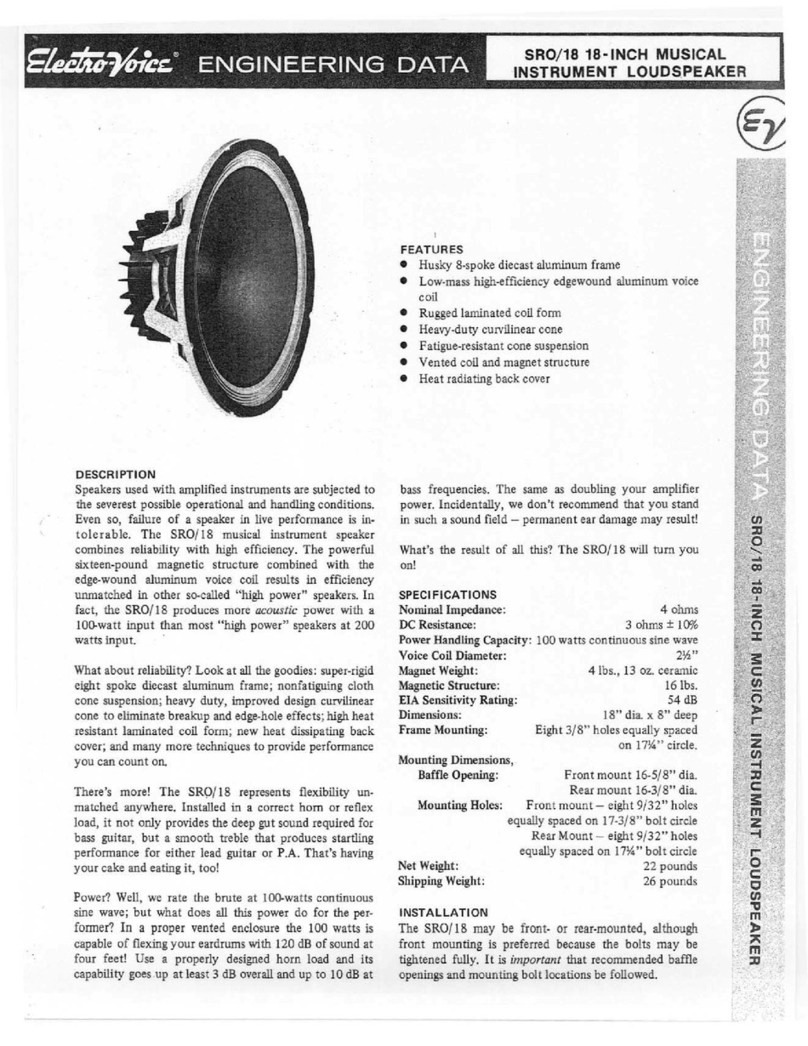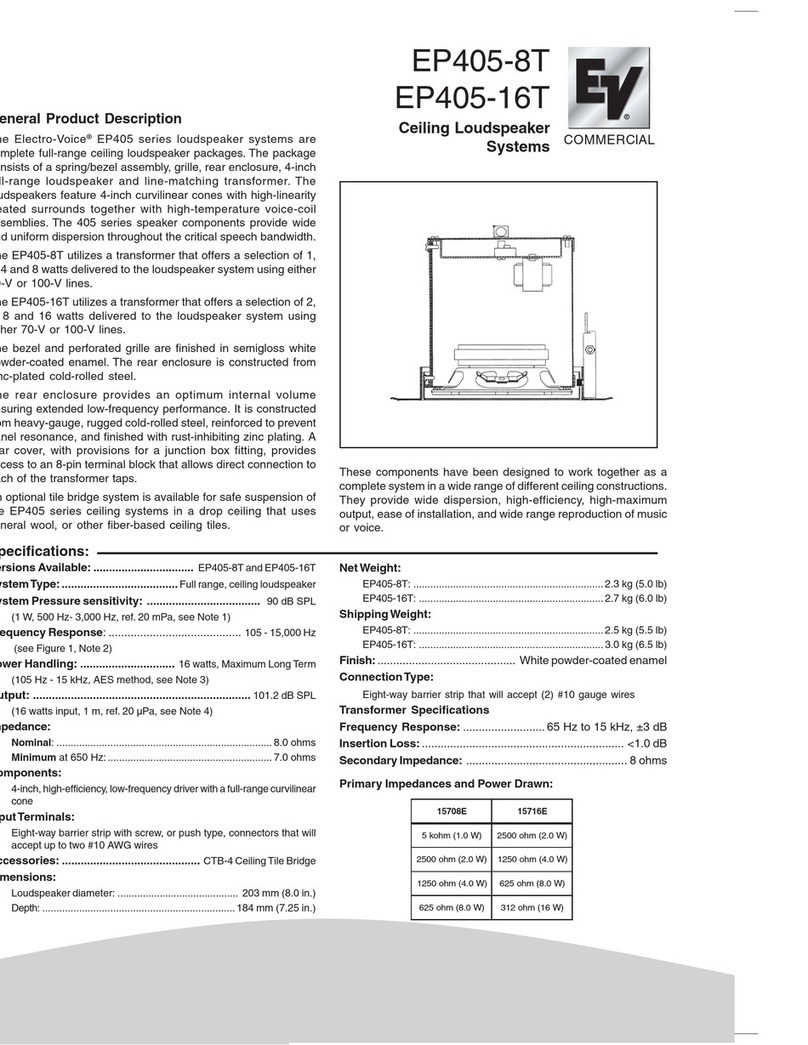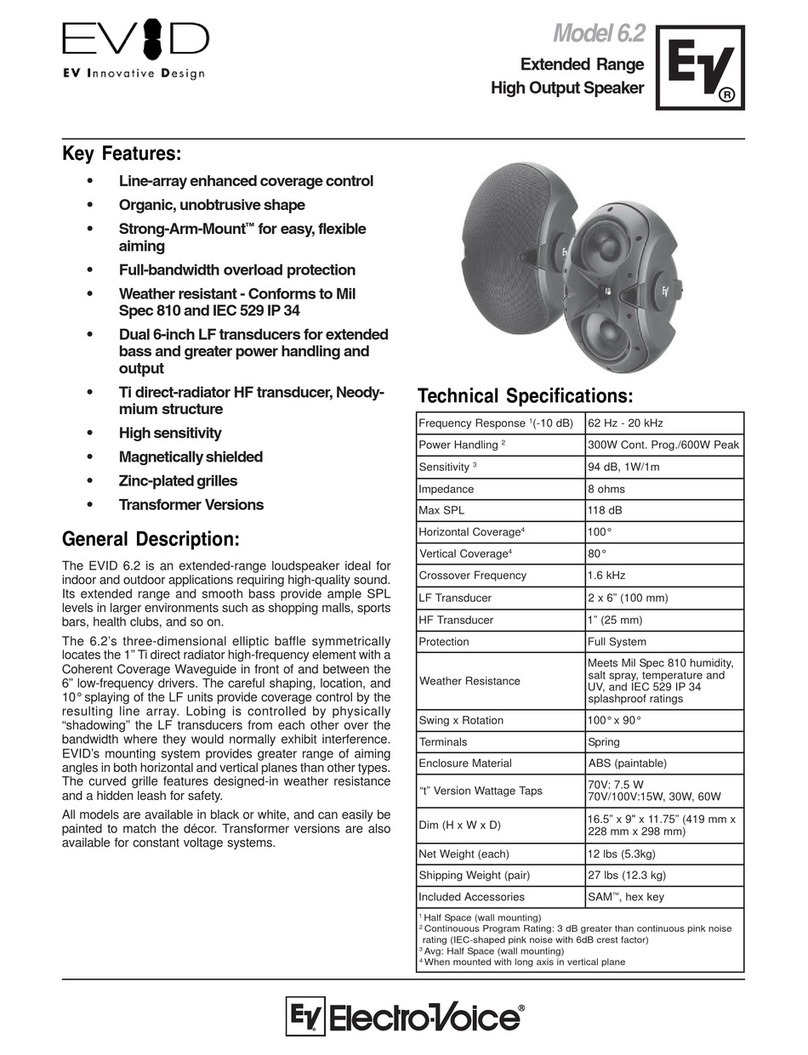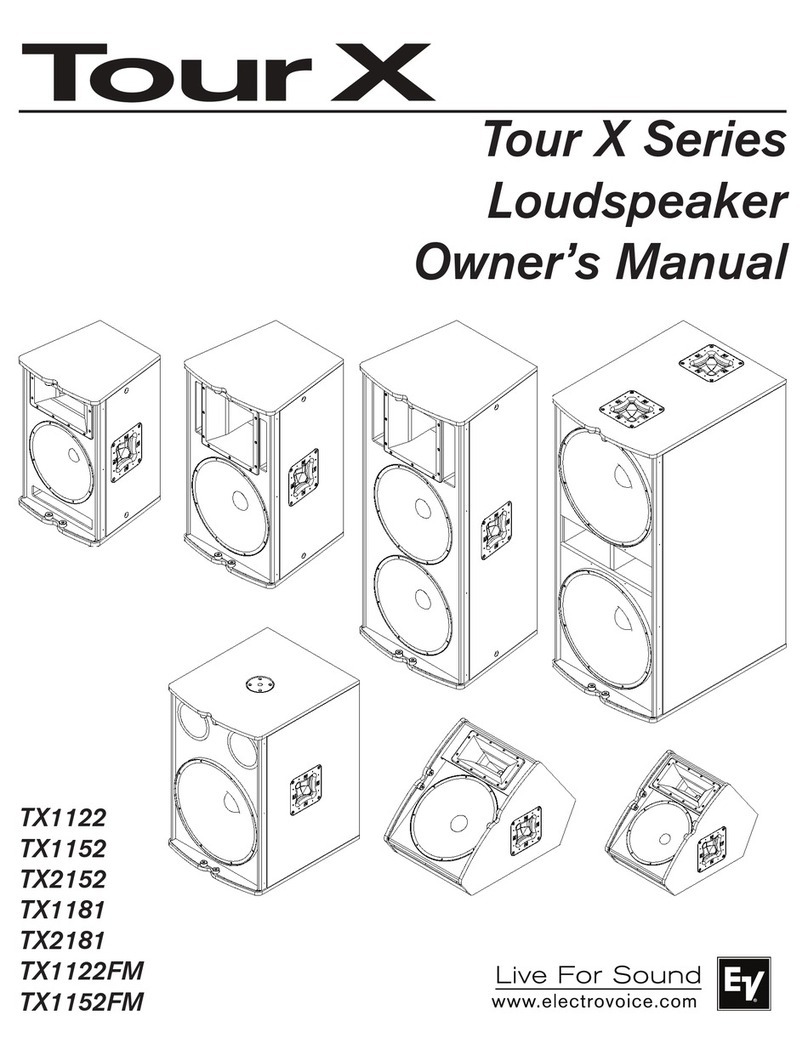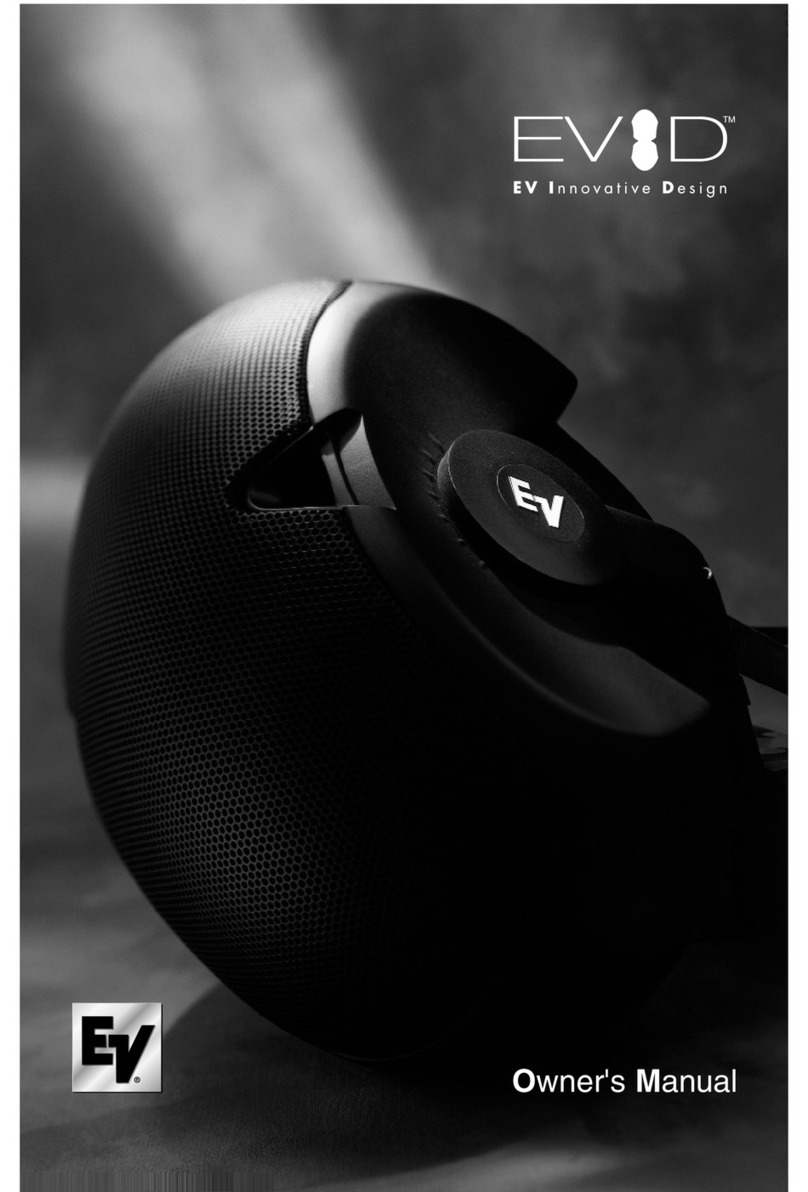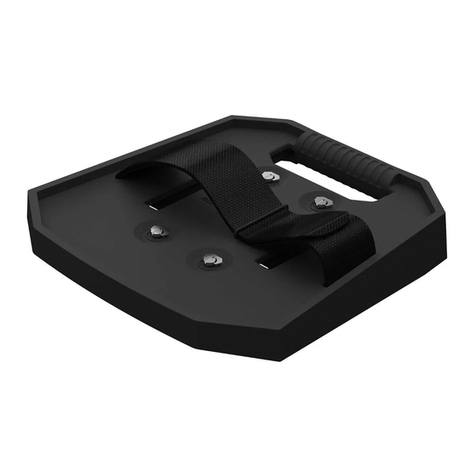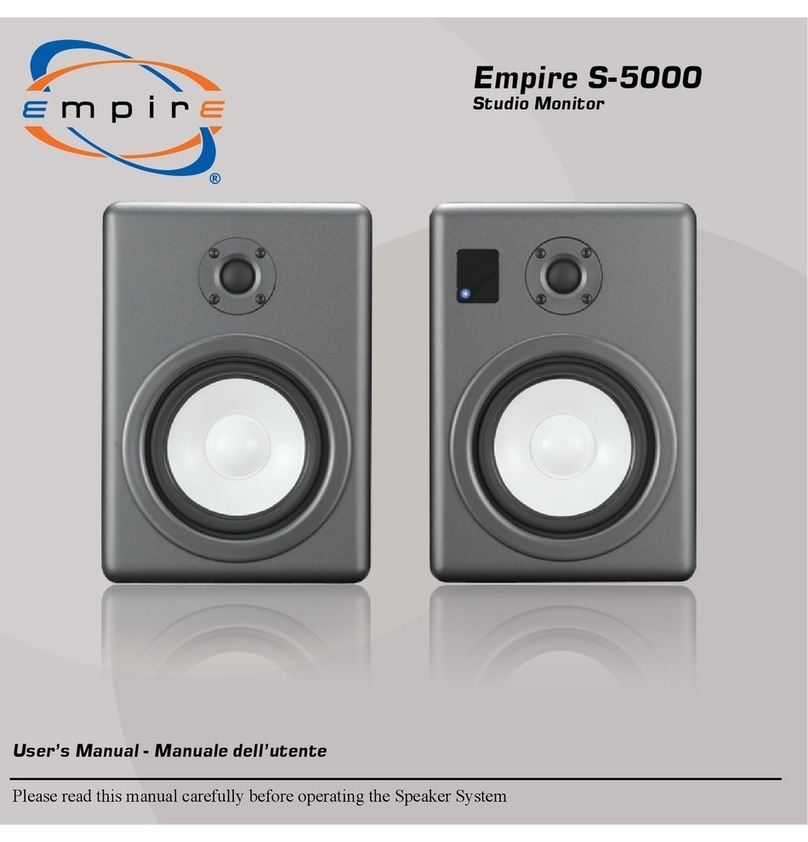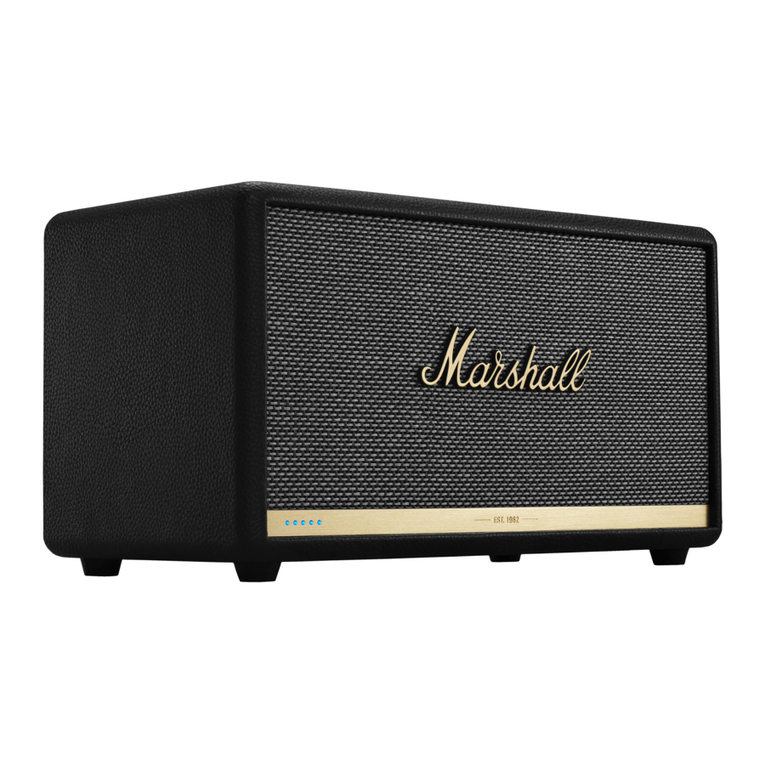Distortion
Response
10%
Rated
Input
Power
at
100 Hz
(on
axis
at
1
meter
from
system;
see
Figure
5),
Second
Harmonic,
50 Hz: 9.0%
80 Hz: 5.0%
200 Hz: <1.0%
Third
Harmonic,
50 Hz: 3.5%
80 Hz: 1.3%
200 Hz: <1.0%
Transducer
Complement,
Low
Frequency:
EVX150A 381-mm (15-in.) woofer
in
a vented enclosure
Box
Tuning
Frequency,
Normal:
38Hz
Step-Down:
27 Hz
Polarity:
A positive voltage applied to the positively
marked input terminal produces a positive
acoustic pressure at the front of the
system
Input
Connections:
#10 screw terminals on barrier strip; each
driver can be individually accessed
Enclosure
Materials
and
Color:
Textured black painted 7-ply void-free
birch
Grille:
Black powder coated, vibration-resistant
steel, removable
Suspension:
Integral three-point flying system (accepts
Ancra 42546-10 single-stud tie-down cargo
fitting; four fittings supplied with system;
see Suspending PIM-151 Enclosures
section)
Dimensions
(see
Figure
6),
Height:
911
mm (35.9 in.)
Width
at
Front:
575 mm (22.7 in.)
Width
at
Rear:
359 mm (14.1 in.)
Depth:
438 mm (17.2 in.)
Side-Wail
Draft
Angle:
15°
Net
Weight:
34.0
kg
(75 Ib)
Shipping
Weight:
40.0 kg (85 Ib)
DESCRIPTION
AND
APPLICATIONS
The Electro-Voice PIM-151 is a compact, trap-
ezoidallow-frequency speakersystem for per-
manentinstallation. A 15-inchwooferismounted
in an optimally vented enclosure. The PIM-151
is part of the
PI
Matrix Series
Tt
",
a highlyflexible
group of full-range and low-frequency systems
for applications where compact systems are
appropriate. Many performing arts centers,
clubs, auditoriums, sportsfacilities and houses
of worship are candidates for the
PI
Matrix
Series
Tl
•
4•
The flexibility of the
PI
Matrix Series™ allows
the designerto customize a system to both suit
the acoustic environment and meet a wide
varietyofarchitectural and mechanical require-
ments.
PIM-151 options include low-frequency driv-
ers, enclosure materials and finish, grilles,
suspension hardware and input-panel con-
nections, giving the sound contractor or con-
suitant literally thousands
of
combinations to
satisfy the overall system design criteria.
The PIM-151 standard configuration employs
the EVX-150A 381-mm (15-inch) long-throw,
extended-reliabilitywoofer. Operatingbetween
45 and 1,800 Hz
in
a compact enclosure, the
EVX-150Acan handle very high levels ofinput
power, producing high acoustic output with
relatively low distortion.
The PIM-151 is equipped with a number of
additional features to make operation and in-
stallation easy and secure. A proprietarystruc-
tural extrusion is incorporated into the enclo-
sure, providing safe and flexible suspension
(seeSuspending PIM-151 Enclosuressection).
Up to two enclosures of the same footprint can
be suspended without additional support (as
long asthe lowersystem is notheavierthan the
uppersystem), soarrayscan becreatedquickly
and easily. The grille is composed ofvibration-
resistant steel for excellent driver protection,
and an optional foam cover can be added for
betterprotection when used outdoors. Besides
the standard black-painted finish, the enclo-
sure can also be ordered primed in white for
painting with ordinary paints, unfinished for
staining orwith ourspecialWolverine<!>weather-
resistant finish for outdoor applications. The
PIM-151 drivercan be serviced from the front of
the enclosure.
A
complete
listing
of
all
system
options
Is
shown
In
Figure
1.
SUSPENDING PIM-151 ENCLOSURES
Suspending
any
object is potentially danger-
ous
and
shouldbe attempted only
by
individu-
als who have a thorough knowledge
of
the
techniques
and
regulations
of
hanging over-
head. Electro-Voice stronglyrecommends that
the PIM-151 besuspended taking into account
all current national, federal, state
and
local
regulations. It is the responsibility
of
the in-
staller
to
ensure that the PIM-151 is safely
installed in accordance with all such regula-
tions.
If
the PIM-151 is suspended, Electro-
Voice stronglyrecommends thatthe systembe
inspected
at
least once a year.
If
any
sign
of
weakness
or
damage is detected, remedial
action should be taken immediately.
The
PI
Matrix Series™ enclosures are sus-
pended using the following approach, which
has been approved by an independent struc-
tural engineer. Every enclosure incorporates
six independent suspension points, three on
the top and three on the bottom. A minimum of
three points must be used at all times to sus-
pend the enclosure. The suspension points,
which "tie" the top and sides of the enclosure
together, are made of structural aluminum.
Each suspension point mates to an Ancra
42546-10 locking fitting (four are supplied with
each enclosure ordered with this option, EV
#20562), andeachpointhasabreakstrength of
907 kg (2,000 Ib) in anydirection.' A maximum
of two enclosures can be "daisy chained" to-
gether, allowing the construction of vertical
arrays. This also applies to other PIM models
with the same footprint, as long as the lower
system is no heavierthan the upper system. If
the lower system is heavier,
or
if longer arrays
are required, provision must be made to inde-
pendentlysuspend each enclosure. The Ancra
42546-10 fitting incorporates a safety pin to
prevent accidental release, and it should be
engaged at all times.
CONNECTIONS
Depending on the option ordered, barrier strip
or Neutrik
Speakon<!>
connectors are used for
input connections. Both barrier strips are wired
in
parallel and connected to the single woofer.
In
the
Speakon<!>
connector options, pins 1
+/1-
and 2+/2- are
in
parallel and connected to the
woofer. The driveris connected so that a posi-
tive voltage applied to the positively marked
terminal will produce a positive acoustic pres-
sure at the front of the system.
FREQUENCY RESPONSE
PIM-151 axial frequency response was mea-
sured in Electro-Voice's large anechoic cham-
ber
at a distance of 3.0 meters (10 feet) with
swept sine-wave input. Figure 2 shows the
typical system response, with a 4-volt drive,
normalized for a 1-watt input and a 1-meter
distance.
DIRECTIVITY
The directional characteristics of the PIM-151
were
measured
in
Electro-Voice's
large
anechoic chamber, with a test signal of one-
third-octave filtered pink noise at the frequen-
cies indicated. A full spherical measurement
system, which is fully compatible with Mark IV
Audio's AcoustaCADDTM computer-aided
de-
sign program, was used. All directional infor-
mation was measured at
6.1
meters (20 feet).
Figure 7 illustrates the nominal horizontal and
vertical polar responses, with the long system
axis vertical.
Figure 3 illustrates the horizontal and vertical
beamwidths. Beamwidth is the angle at which
the horizontal and vertical polar responses
have decreased in level by 6 dB when com-
pared to the on-axis frequency response.
Figure 4 represents the total directivity of the
PIM-151. The directivity factor,
Re
(Q), is the
relative value, ata point, when compared to an
ideal spherical response. The directivity index
(0,) is calculated by 0, =
1010g,oR.
SERVICE
In the unlikely event the PIM-151 requires ser-
vice, the driver can be replaced or serviced
from the front. A service data sheet is available
from Electro-Voice.
POWER-HANDLING TEST
Electro-Voice components and systems are
manufactured to exacting standards, ensuring
they will hold up, not only through the most
rigorousofpowertests, butalsothrough contin-
ued use in arduous, real-life conditions. Two
main test specifications are used: the AES
Recommended Practice for Specification of
LoudspeakerComponentsUsed
in
Professional
Audio and Sound Reinforcement (AES2-19841
ANSI S4.26-1984) and the EIA Loudspeaker
PowerRating Full Range(EIA RS-426-A 1980).
Both of these specifications use random-noise
spectrum which mimicstypical musicand tests
the thermal and mechanical capabilities of the
components. Electro-Voicewill supportrelevant
additionalstandards as and when theybecome
available.Extreme, in-housepowertests,which
push the performance boundaries of the com-
ponents, are also performed and passed to
ensure years of trouble-free service.
The PIM-151 passes EIA RS-426-A 1980 with
the following values:
R~A
=5.8 ohms (1.15 x RE)
PE(max) =600 watts
Test voltage = 59.0 volts rms
118 volts peak (+6 dB)
STEP-DOWN
Step-down is a method of extending the low-
frequency response by increasing the power
input to the system instead of the enclosure
volume. In step-down mode, the enclosure is
tuned to 0.707 the normal frequency. This
increases the output at the new tuning fre-
quency and reduces the output at the original
tuning frequency. This smoothly falling ampli-
tude responsecan beequalizedtoobtain anew
3-dB-down point in the region of 0.7 that of the
original. To obtain a similar response without
step-down would require an enclosure with at
least twice the volume.
1.
For additional information, contact Ancra International
at
6061371-7272 ortollfree (withinU.S.only)at
8001233·5138.
